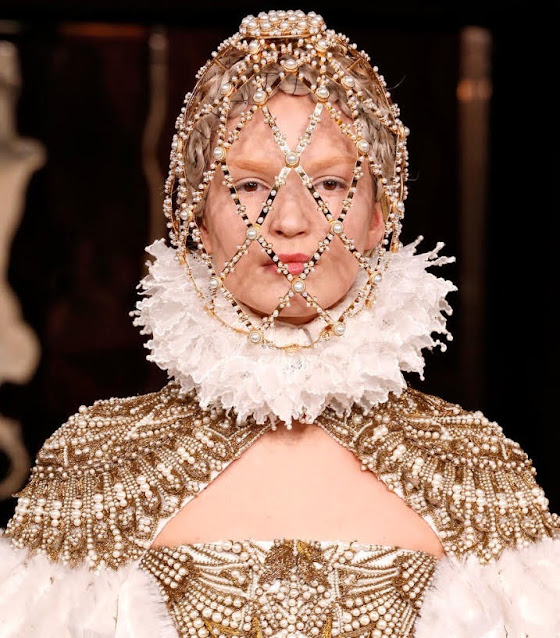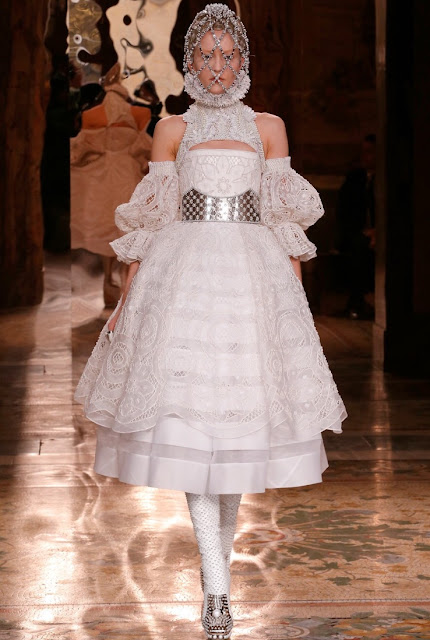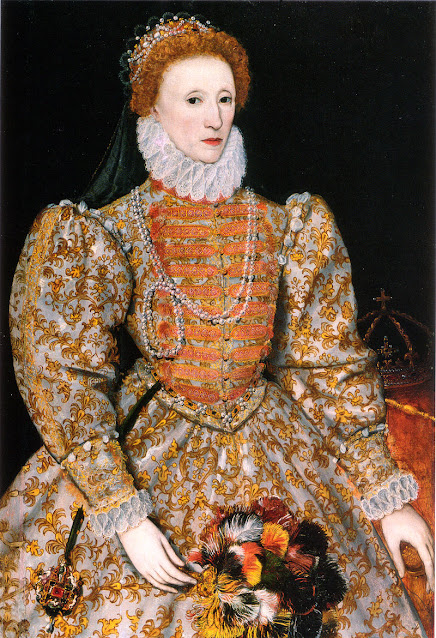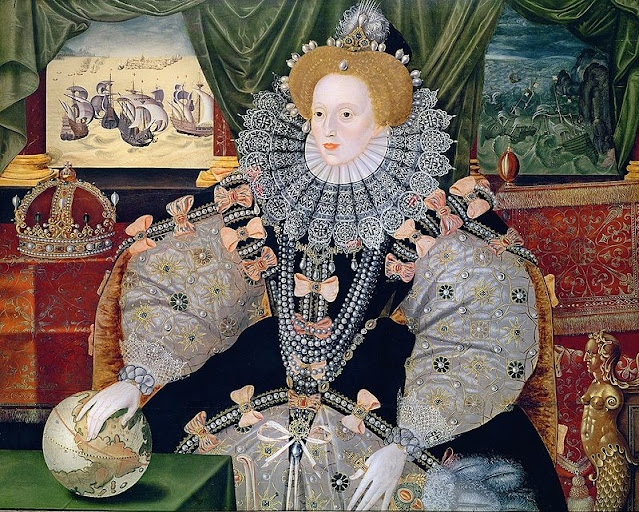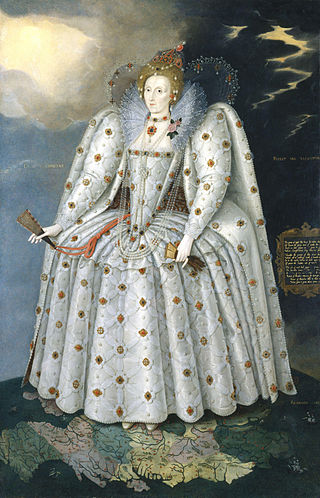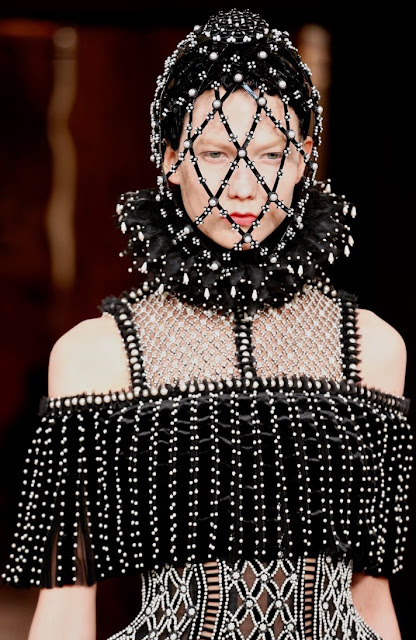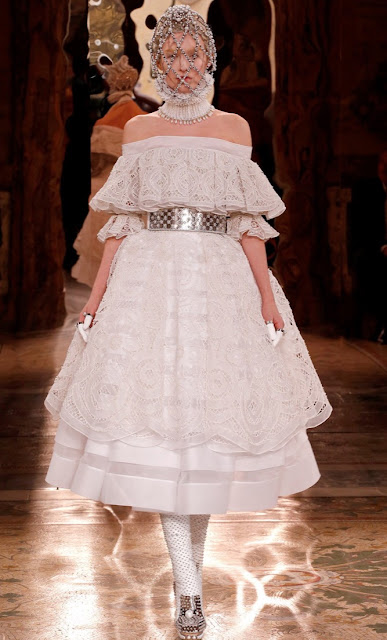Alexander McQueen Fall 2013
Queen Elizabeth I continues to be recognized as one of the greatest leaders of her time. She ruled as a single woman on the throne of England from 1558-1603 in what has been labeled the golden era. While serving as Queen, she revolutionized the religious system by establishing the English Protestant church, resisted expectations to marry simply based on protocol, helped the arts blossom, expanded the territory and led one of England’s largest military victories.
Though historians can look back on leaders and analyze what they did to make them memorable or worth studying, Elizabeth was recognized within her lifetime and soon after her death for her greatness. What about her leadership style helped people of the Elizabethan era see the strengths of their Queen?
Elizabeth did not leave her image and legacy to chance. Centuries before social media and advertising, she cultivated her brand through fashion, art, jewelry and daily objects like coins. Just as 21st century celebrities use Instagram or red carpet style choices to shape the public’s perception, Elizabeth commissioned a high volume of paintings so the public would know their Queen and what ideals she represented.
Shortly after taking the throne in 1559, “The Coronation Portrait” (above) was created to memorialize the historic occasion. Elizabeth was painted holding the orb and sceptre, both symbols of authority as pointed out by the National Portrait Gallery. Though young and unmarried, it was important for Elizabeth to quickly establish herself as a strong Queen. Even before actions could be established to solidify her position, she was able to harness the power of branding through symbols to let others know she was stepping into this authoritative position without hesitation.
The “Darnley Portrait” from 1575 features Elizabeth in a heavy brocade dress with the period’s iconic neck and wrist ruffs. The doublet style bodice featured details similar to those on a military coat. The National Portrait Gallery notes that the masculinity of the doublet “helps create an image of a woman equal to her male counterparts in other European countries.” Her dress was not simply a dress, it was a symbol of her status and position on a global stage of rulers.
Additionally, the painting includes things like a fan and jewels, most likely gifts from her courtiers. Just as Instagram influencers and celebrities note that their shoes or skirt were gifted from a particular brand, Elizabeth featured symbolic gifts to not only communicate meaning to the public, but to also let her supporters know they were still in her inner circle.
When Elizabeth had a success to celebrate, she memorialized the event with fashion and art. Following the massive defeat of the Spanish Armada, Elizabeth commissioned the “Armada Portrait” in 1588. She knew that her military victory would strengthen her position as a global leader and force to be reckoned with, regardless of marital status or gender. To make sure everyone knew of her success, art was once again the best form of communication since an interview with Oprah was not yet an option.
"The Ditchley Portrait" by Marcus Gheeraerts the Younger, 1592
Symbols often seen in her clothing choices included the neck ruff, pearls and ermine. Each fashion detail became a part of her brand and image.
Much like the fashion seen in the original paintings of Elizabeth, the designs on the Alexander McQueen runway showcase key elements of style, power and messaging. Ornamentation is heavy to represent wealth and prestige, while neck ruffs add elegance and distance. Heavily belted waists are much like the corsets hidden beneath Queen Elizabeth's gowns.
The neck ruff was a core accessory in the Elizabethan era. Its design instantly created distance and a barrier between the wearer and audience. By wearing these decorative pieces, Elizabeth was in some ways separating herself from those nearby while putting a focus on her face as a pivotal piece of her brand.
Just as they are now, pearls were used by Elizabeth to communicate purity. These were the perfect accessory for the Virgin Queen to continue to position herself as the untouched Queen married only to her country.
In the McQueen gowns, pearls make an appearance alongside gold beads and brocade-like details. Billowing sleeves are similar to the Elizabethan style, even with the criss-cross quilting pattern like the one seen in the "Ermine Portrait" below. The elaborate details communicate a message of wealth, power and purity.
"The Ermine Portrait" by William Segar, 1585
The use of ermine to line dresses or cloaks instantly spoke of luxury. Fur of any type has historically been worn by the wealthy. But ermine specifically was used by royalty to showcase “moral purity" since the ermine would “rather die than be defiled/soiled” according to the Fur Insider. By wearing this fur, Elizabeth supported her branded image as true royalty and a Queen that would work on behalf of her people without compromise.
These dramatic black designs have heavy beading and a cage-like headpiece that helps represent a similar message as Elizabeth's "Ermine Portrait." In addition to the ruff adding distance, the cage acts like a modern ermine alternative to separate the wearer and keep her pure from outsiders.
Taking a cue from the original Queen of branding, you too can harness the power of symbols and media to communicate your personal brand. Though your picture may not be worn as jewelry or found on coins, you can utilize things like fashion choices, social media and your LinkedIn profile to help cultivate your brand image.
And as these designs from McQueen prove, a dress is always more than a dress. It holds the power to communicate messages...you only have to decide what it is you wish to say.
Sources and Further Reading:
1. National Portrait Gallery, “The Queen’s Likeness: Portraits of Elizabeth I”
2. All Elizabeth I portraits via Wikipedia
3. Runway images via Vogue for the Alexander McQueen Fall 2013 Collection
4. Ermine history in "The Royal Touch: Ermine"


